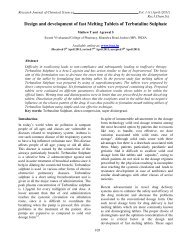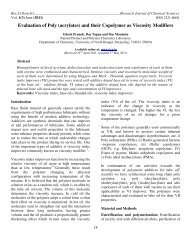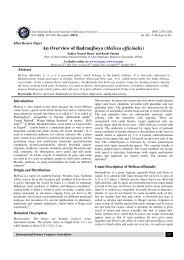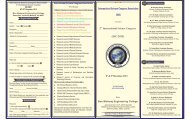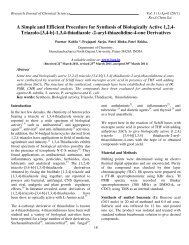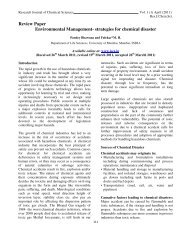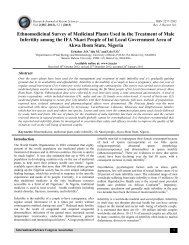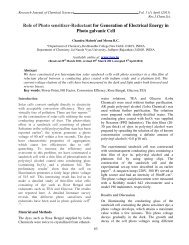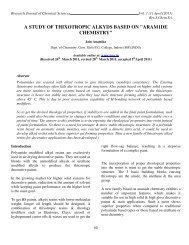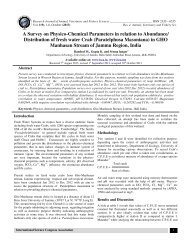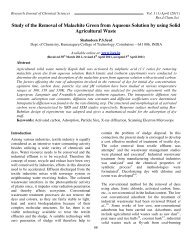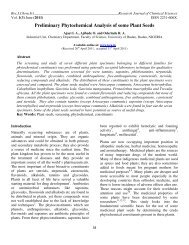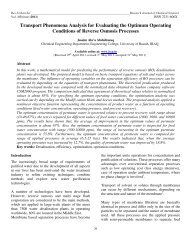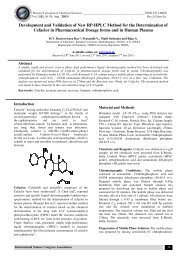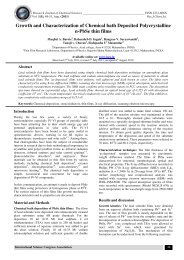Dyeing of Bamboo with Tea as a natural Dye - ISCA
Dyeing of Bamboo with Tea as a natural Dye - ISCA
Dyeing of Bamboo with Tea as a natural Dye - ISCA
You also want an ePaper? Increase the reach of your titles
YUMPU automatically turns print PDFs into web optimized ePapers that Google loves.
Research Journal <strong>of</strong> Engineering Sciences ___________________________________________ ISSN 2278 – 9472<br />
Vol. 1(4), 21-26, October (2012)<br />
Res. J. Engineering Sci.<br />
<strong><strong>Dye</strong>ing</strong> <strong>of</strong> <strong>Bamboo</strong> <strong>with</strong> <strong>Tea</strong> <strong>as</strong> a <strong>natural</strong> <strong>Dye</strong><br />
Kaur Satindar 1 , Chattopadhyay D.P. 2 and Varinder Kaur 3<br />
1 Department <strong>of</strong> Food Sciences and technology, Guru Nanak Dev University, Amritsar, INDIA<br />
2 Department <strong>of</strong> Textile Chemistry, Faculty <strong>of</strong> Technology and Engineering, The M. S. University <strong>of</strong> Baroda, Vadodara, INDIA<br />
3 Department <strong>of</strong> Applied Chemical Sciences and Technology, Guru Nanak Dev University, Amritsar, INDIA<br />
Abstract<br />
Available online at: www.isca.in<br />
Received 3 rd October 2012, revised 16 th October 2012, accepted 20 th October 2012<br />
<strong><strong>Dye</strong>ing</strong> <strong>of</strong> bamboo fabric <strong>with</strong> green tea <strong>as</strong> a <strong>natural</strong> colorant had been investigated. The dyeing process w<strong>as</strong> carried out<br />
(<strong>with</strong> and <strong>with</strong>out mordanting) using pre-extracted dye stock employing either 100% water or solvent: water (1:9) mixture <strong>as</strong><br />
the extraction medium. Three different qualities <strong>of</strong> tea leaves were used <strong>as</strong> source <strong>of</strong> colour extraction. The dyeing properties<br />
on bamboo fabric had been evaluated. <strong>Dye</strong> exhaustion, colour depth in terms <strong>of</strong> K/S, w<strong>as</strong>hing f<strong>as</strong>tness, light f<strong>as</strong>tness, etc<br />
were compared for dyeing performed at 90 o C for 1hour using four extracted dye stocks on pre-mordanted and unmordanted<br />
samples.<br />
Keywords: <strong>Bamboo</strong>, tea leaves, f<strong>as</strong>tness properties, solvents.<br />
Introduction<br />
Textile materials are coloured for value addition, looks and<br />
fulfilling the desires <strong>of</strong> the customers. Anciently, this purpose <strong>of</strong><br />
colouring textile w<strong>as</strong> initiated using <strong>natural</strong> sources, until<br />
synthetic dyes were invented. Almost all the synthetic dyes<br />
being synthesized from petrochemical sources through<br />
hazardous chemical processes pose threat to the environment.<br />
However, worldwide environment protection and safety<br />
renewed the interest <strong>of</strong> the people on <strong>natural</strong> products like<br />
<strong>natural</strong> fibres and <strong>natural</strong> dyes 1 .<br />
For successful commercial application <strong>of</strong> <strong>natural</strong> dyes for any<br />
particular fibres, the appropriate and standardized techniques <strong>of</strong><br />
dyeing for that particular fibre dye system need to be adopted.<br />
Relevant scientific studies and optimization <strong>of</strong> dyeing process<br />
variables, dyeing kinetics study and test <strong>of</strong> compatibility <strong>of</strong><br />
selective <strong>natural</strong> dyes are very important 2 .<br />
<strong>Tea</strong> is a mixture <strong>of</strong> variously processed leaves <strong>of</strong> an evergreen<br />
shrub, Camellia sinensis, which is the most popular nonalcoholic<br />
beverage in the world. Flavonoids, flavonols and<br />
phenolic acids make up approximately 30% <strong>of</strong> dried Camellia<br />
Sinensis by weight. Most <strong>of</strong> the polyphenols present are<br />
flavonols commonly known <strong>as</strong> catechins, <strong>with</strong> epicatechin and<br />
its derivatives being the most predominant forms. The gallic<br />
acid ester epigallocatechin gallate (EGCG) is present in the<br />
highest concentration, making up over 61% <strong>of</strong> the epicatechin<br />
derivatives included in the green tea leaves 3 . Other green tea<br />
polyphenols include flavonoids, and their glycosides, depsides<br />
such <strong>as</strong> chlorogenic acid and coumarylquinic acid, and a<br />
phenolic acid unique to tea, theogallin. Caffeine makes up an<br />
additional 3%, and there are trace amounts <strong>of</strong> the<br />
methylxanthines theophylline and theobromine, and an amino<br />
acid unique to tea, theanin 4 .<br />
<strong>Bamboo</strong> is a <strong>natural</strong>ly occurring composite material <strong>as</strong> it<br />
consists <strong>of</strong> cellulose fibres embedded in a lignin matrix. It<br />
grows abundantly in most <strong>of</strong> the tropical countries. Cellulose<br />
fibers are aligned along the length <strong>of</strong> the bamboo, providing<br />
maximum tensile strength and rigidity in that direction. It is an<br />
environmentally friendly product 5 . Through a process <strong>of</strong><br />
hydrolysis-alkalization and multi-ph<strong>as</strong>e bleaching, starchy pulp<br />
is refined from <strong>Bamboo</strong>. Chemical fibre factories then process it<br />
into bamboo fibers. Repeated technological analysis h<strong>as</strong> proved<br />
that this kind <strong>of</strong> fiber h<strong>as</strong> thinness and whiteness close to finely<br />
bleached viscose and h<strong>as</strong> a strong durability, stability and<br />
tenacity 6 . Some work on the application <strong>of</strong> tea on wool, silk 7 ,<br />
jute and cotton 8 are available in the literature. Applications <strong>of</strong><br />
heena extracts on polyester 9 and tea on wool 10 using solvent <strong>as</strong><br />
dyeing medium are also reported in the literature.<br />
In the present work, <strong>natural</strong> tea w<strong>as</strong> used to dye bamboo fabric.<br />
The colour <strong>of</strong> the tea leaves w<strong>as</strong> extracted using four different<br />
extraction mediums viz. 100% water, water: acetone (9: 1 v/v),<br />
water: methanol (9:1 v/v) and water: acetonitrile (9:1 v/v).<br />
Green tea plants 11 are cl<strong>as</strong>sified <strong>as</strong> Camellia sinensis. The<br />
different cl<strong>as</strong>ses <strong>of</strong> compounds found in green tea include amino<br />
acids, catechin, caffeine, carbohydrates, carotenoids,<br />
chlorophyll, lipids, minerals, nucleotides, organic acids,<br />
saponins, polyphenols, unsaponifiable and volatile<br />
compounds 12 . The dyeing w<strong>as</strong> carried out <strong>with</strong> the dye extracted<br />
from three different qualities <strong>of</strong> tea leaves using four different<br />
solvents. <strong>Dye</strong> exhaustion, colour depth in terms <strong>of</strong> K/S, w<strong>as</strong>hing<br />
f<strong>as</strong>tness, light f<strong>as</strong>tness, etc were compared for dyeing carried<br />
out using pre-extracted dye in different extraction mediums.<br />
The effect <strong>of</strong> mordanting in such dyeing w<strong>as</strong> also investigated<br />
and compared.<br />
International Science Congress Association 21
Research Journal <strong>of</strong> Engineering Sciences________________________________________________________ ISSN 2278 – 9472<br />
Vol. 1(4), 21-26, October (2012)<br />
Res. J. Engineering Sci.<br />
Material and Methods<br />
<strong>Tea</strong> leaves <strong>of</strong> three different qualities viz., Hyson (Silighuri),<br />
Kawa (Assam) and IHBT (Palampur) were collected from M/S<br />
Sethi <strong>Tea</strong> Trading Co. Amritsar. The quantitative<br />
estimation/analysis <strong>of</strong> the flavanols and polyphenols contents<br />
were not performed. Plain weave bamboo fabric (EPI: - 168,<br />
PPI: - 92, GSM: - 424 gm/m 2 ) w<strong>as</strong> used in this study.<br />
Extraction <strong>of</strong> dye from tea leaves: 2 gram <strong>of</strong> tea leaves w<strong>as</strong><br />
weighed. The dye w<strong>as</strong> extracted in four different solvents viz.<br />
water, acetone, acetonitrile and methanol by boiling the leaves<br />
in 100ml solvent for 1 hour. Each solution w<strong>as</strong> then filtered to<br />
remove the residual leaves. The filtrate w<strong>as</strong> concentrated by<br />
boiling until the volume left w<strong>as</strong> one fourth. This solution w<strong>as</strong><br />
again filtered so <strong>as</strong> to remove any suspended particle.<br />
<strong><strong>Dye</strong>ing</strong> <strong>of</strong> bamboo: <strong><strong>Dye</strong>ing</strong> w<strong>as</strong> performed using two different<br />
ways viz. (a) <strong><strong>Dye</strong>ing</strong> <strong>of</strong> pre-mordanted bamboo fabric (b)<br />
<strong><strong>Dye</strong>ing</strong> <strong>of</strong> bamboo fabric <strong>with</strong>out mordanting.<br />
Mordanting: Pre-mordanting treatment w<strong>as</strong> conducted using<br />
copper sulphate. <strong>Bamboo</strong> fabric samples were pre-mordanted by<br />
treating it <strong>with</strong> 5.0% (owf) copper sulphate at 40 o C for 30<br />
minutes <strong>with</strong> a material to liquor ratio <strong>of</strong> 1:30. After<br />
mordanting the samples were rinsed in cold water to remove the<br />
excess <strong>of</strong> mordant and used for dyeing <strong>as</strong> described in the<br />
following section.<br />
<strong><strong>Dye</strong>ing</strong>: <strong><strong>Dye</strong>ing</strong> <strong>of</strong> the pre-mordanted samples w<strong>as</strong> performed<br />
for 1 h at 90 o C in an open bath beaker dyeing machine at 30:1<br />
liquor to material ratio. The dyed samples were rinsed in cold<br />
water and dried in open air.<br />
Procedure for dyeing <strong>of</strong> <strong>Bamboo</strong>: 5gm sample <strong>of</strong> bamboo<br />
fabric w<strong>as</strong> dyed <strong>with</strong> the extracted dye liquor. The dyeing w<strong>as</strong><br />
performed <strong>as</strong> per the condition given in table 1 and the<br />
temperature pr<strong>of</strong>ile shown in figure 1.<br />
Table-1<br />
Conditions for dyeing <strong>of</strong> bamboo <strong>with</strong> tea<br />
Parameters<br />
Conditions<br />
Temperature<br />
90 o C<br />
Time<br />
60 minutes<br />
pH<br />
Neutral<br />
MLR 1:30<br />
Colour me<strong>as</strong>urement: The K/S values <strong>of</strong> the dyed samples<br />
were me<strong>as</strong>ured (D 65 illuminant, 10 o observer) using spectra fl<strong>as</strong>h<br />
600 spectrophotometer interph<strong>as</strong>ed <strong>with</strong> computer colour<br />
matching system.<br />
W<strong>as</strong>hing f<strong>as</strong>tness: Colour f<strong>as</strong>tness to w<strong>as</strong>hing w<strong>as</strong> evaluated<br />
using standard ISO 105:CO3 test 13 . ECE reference detergent<br />
and steel balls were employed during w<strong>as</strong>hing.<br />
Light f<strong>as</strong>tness: Light f<strong>as</strong>tness w<strong>as</strong> determined using ISO: 105<br />
B02: 2000 test 13 using xenon arc lamp and blue wool reference<br />
standards.<br />
Determination <strong>of</strong> exhaustion: The dye exhaustion % w<strong>as</strong><br />
calculated using following equation.<br />
– <br />
= × 100 (1)<br />
<br />
Where A 0 = absorbance <strong>of</strong> dye liquor before dyeing, A 1 =<br />
absorbance <strong>of</strong> dye liquor after dyeing.<br />
Figure-1<br />
<strong><strong>Dye</strong>ing</strong> cycle<br />
International Science Congress Association 22
Research Journal <strong>of</strong> Engineering Sciences________________________________________________________ ISSN 2278 – 9472<br />
Vol. 1(4), 21-26, October (2012)<br />
Res. J. Engineering Sci.<br />
Results and Discussion<br />
The various conditions used in the dyeing <strong>of</strong> bamboo fabric<br />
samples and their codes are given in table 2. For samples 1, 5<br />
and 9, aqueous extracts <strong>of</strong> Kawa, Hyson and IHBT tea were<br />
used. From table 3 and 4, it is clear that the exhaustions were<br />
satisfactory for all the three tea extracts used viz. Kawa, Hyson<br />
and IHBT for dyeing <strong>of</strong> bamboo. To explore the chances <strong>of</strong><br />
better colour extraction beside 100% water the three other<br />
extraction systems viz. water: acetone (9: 1 v/v), water:<br />
methanol (9:1 v/v) and water: acetonitrile (9:1 v/v) were tried.<br />
Among the four extraction systems, water: acetone system<br />
produces highest colour uptake on bamboo. Among the three<br />
types <strong>of</strong> tea extracts used both Hyson and IHBT produced<br />
higher colour yield compared to Kawa for the identical dyeing<br />
conditions. The pre-mordanting treatment enhanced the dye<br />
uptake for all the samples.<br />
Significant incre<strong>as</strong>e in the brightness <strong>of</strong> the dyed samples w<strong>as</strong><br />
observed in c<strong>as</strong>e <strong>of</strong> aqueous extracted dye stock. This<br />
comparison eliminates the requirement <strong>of</strong> solvent pre-extraction<br />
<strong>of</strong> tea leaves and motivates us to use directly the aqueous extract<br />
<strong>of</strong> tea which also reduces the cost <strong>of</strong> dyeing. The shades <strong>as</strong><br />
presented in table 3 ranged from medium brown to dark brown.<br />
The resulting w<strong>as</strong>h f<strong>as</strong>tness (table 5) <strong>of</strong> the dyed samples w<strong>as</strong><br />
good to excellent in all the c<strong>as</strong>es. The colour staining rating h<strong>as</strong><br />
been observed very good (4-5) in all the dyeing trails. Among<br />
the three qualities <strong>of</strong> tea, the light f<strong>as</strong>tness <strong>of</strong> Kawa w<strong>as</strong> found<br />
to be best which w<strong>as</strong> further improved after mordanting in c<strong>as</strong>e<br />
<strong>of</strong> Hyson and IHBT due to the formation <strong>of</strong> coordination<br />
complexes <strong>of</strong> the dye <strong>with</strong> the mordants.<br />
Conclusion<br />
This study demonstrated that tea can be used <strong>as</strong> a colorant for<br />
dyeing <strong>of</strong> bamboo using aqueous extraction <strong>of</strong> tea leaves.<br />
Among the various organic solvent extraction methods used,<br />
water-acetone extraction system w<strong>as</strong> found to be the best one.<br />
But pure aqueous system w<strong>as</strong> also found to be equally<br />
satisfactory so far <strong>as</strong> dye exhaustion and colour yields are<br />
concerned. The dyed samples were <strong>of</strong> light brown to dark brown<br />
shades and exhibited acceptable f<strong>as</strong>tness properties. It w<strong>as</strong><br />
found that Hyson and IHBT tea generated maximum colour<br />
depth among the three varieties <strong>of</strong> tea used. Kawa quality w<strong>as</strong><br />
found to develop better light f<strong>as</strong>tness on bamboo.<br />
Table-2<br />
Various extraction mediums used for colour extraction<br />
S. No. Code Colour Extraction medium used<br />
1 AB1 <strong><strong>Dye</strong>ing</strong> <strong>of</strong> <strong>Bamboo</strong> <strong>with</strong> Kawa tea extract using water <strong>as</strong> extraction medium<br />
2 AB2 <strong><strong>Dye</strong>ing</strong> <strong>of</strong> <strong>Bamboo</strong> <strong>with</strong> Kawa tea extract using mixture <strong>of</strong> water: acetone (9:1 v/v) <strong>as</strong> extraction medium<br />
3 AB3 <strong><strong>Dye</strong>ing</strong> <strong>of</strong> <strong>Bamboo</strong> <strong>with</strong> Kawa tea extract using mixture <strong>of</strong> water: acetonitrile (9:1 v/v) <strong>as</strong> extraction medium<br />
4 AB4 <strong><strong>Dye</strong>ing</strong> <strong>of</strong> <strong>Bamboo</strong> <strong>with</strong> Kawa tea extract using mixture <strong>of</strong> water: methanol (9:1 v/v) <strong>as</strong> extraction medium<br />
5 BB1 <strong><strong>Dye</strong>ing</strong> <strong>of</strong> <strong>Bamboo</strong> <strong>with</strong> Hyson tea extract using water <strong>as</strong> extraction medium<br />
6 BB2 <strong><strong>Dye</strong>ing</strong> <strong>of</strong> <strong>Bamboo</strong> <strong>with</strong> Hyson tea extract using mixture <strong>of</strong> water: acetone (9:1 v/v) <strong>as</strong> extraction medium<br />
7 BB3 <strong><strong>Dye</strong>ing</strong> <strong>of</strong> <strong>Bamboo</strong> <strong>with</strong> Hyson tea extract using mixture <strong>of</strong> water: acetonitrile (9:1 v/v) <strong>as</strong> extraction medium<br />
8 BB4 <strong><strong>Dye</strong>ing</strong> <strong>of</strong> <strong>Bamboo</strong> Hyson tea extract using mixture <strong>of</strong> water: methanol (9:1 v/v) <strong>as</strong> extraction medium<br />
9 CB1 <strong><strong>Dye</strong>ing</strong> <strong>of</strong> <strong>Bamboo</strong> <strong>with</strong> IHBT tea extract using water <strong>as</strong> extraction medium<br />
10 CB2 <strong><strong>Dye</strong>ing</strong> <strong>of</strong> <strong>Bamboo</strong> <strong>with</strong> IHBT tea extract using mixture <strong>of</strong> water: acetone (9:1 v/v) <strong>as</strong> extraction medium<br />
11 CB3 <strong><strong>Dye</strong>ing</strong> <strong>of</strong> <strong>Bamboo</strong> <strong>with</strong> IHBT tea extract using mixture <strong>of</strong> water: acetonitrile (9:1 v/v) <strong>as</strong> extraction medium<br />
12 CB4 <strong><strong>Dye</strong>ing</strong> <strong>of</strong> <strong>Bamboo</strong> <strong>with</strong> IHBT tea extract using mixture <strong>of</strong> water: methanol (9:1 v/v) <strong>as</strong> extraction medium<br />
Mordanted samples are prefixed <strong>with</strong> M before the sample code. (Sample No.s 13-24)<br />
International Science Congress Association 23
Research Journal <strong>of</strong> Engineering Sciences________________________________________________________ ISSN 2278 – 9472<br />
Vol. 1(4), 21-26, October (2012)<br />
Res. J. Engineering Sci.<br />
Table-3<br />
Photographs <strong>of</strong> <strong>Bamboo</strong> fabric samples dyed <strong>with</strong> <strong>Tea</strong> using mordant and <strong>with</strong>out mordant<br />
Sr. No. Sample Codes Samples <strong>with</strong>out mordanting Sr. No. Sample<br />
Codes<br />
Samples <strong>with</strong> mordanting<br />
1. AB1 13. MAB1<br />
2. AB2 14. MAB2<br />
3. AB3 15. MAB3<br />
4. AB4 16. MAB4<br />
5. BB1 17. MBB1<br />
6. BB2 18. MBB2<br />
7. BB3 19. MBB3<br />
8. BB4 20. MBB4<br />
9. CB1 21. MCB1<br />
10. CB2 22. MCB2<br />
11. CB3 23. MCB3<br />
12. CB4 24. MCB4<br />
International Science Congress Association 24
Research Journal <strong>of</strong> Engineering Sciences________________________________________________________ ISSN 2278 – 9472<br />
Vol. 1(4), 21-26, October (2012)<br />
Res. J. Engineering Sci.<br />
Table-4<br />
Exhaustion and colour yield (K/S) <strong>of</strong> bamboo fabric samples dyed <strong>with</strong> tea colour extracted using different solvent systems<br />
Sample Code K/S Exhaustion (%) Sample Code K/S Exhaustion (%)<br />
MAB1 0.55 63.2 MAB1 1.53 70.1<br />
MAB2 0.659 66.0 MAB2 1.66 71.3<br />
MAB3 0.773 63.8 MAB3 1.53 72.1<br />
MAB4 0.8106 65.2 MAB4 1.37 75.8<br />
MBB1 1.18 66.8 MBB1 2.45 72.1<br />
MBB2 1.136 67.3 MBB2 1.66 70.2<br />
MBB3 1.039 63.7 MBB3 1.52 72.8<br />
MBB4 0.812 65.2 MBB4 1.20 75.6<br />
MCB1 0.83 64.8 MCB1 2.91 74.7<br />
MCB2 1.039 69.1 MCB2 1.63 72.6<br />
MCB3 1.317 66.6 MCB3 2.09 74.5<br />
MCB4 1.212 66.2 MCB4 1.90 75.1<br />
Sample<br />
Code<br />
Table-5<br />
F<strong>as</strong>tness properties <strong>of</strong> dyed samples<br />
Staining on different fibres<br />
Light F<strong>as</strong>tness Rating<br />
Secondary<br />
Acetate<br />
Cotton Polyamide PET PAN Wool<br />
AB1 4/5 4/5 4/5 4/5 4/5 3/4 4/5<br />
AB2 4/5 4/5 4/5 4/5 4/5 4/5 4/5<br />
AB3 4/5 4/5 4/5 4/5 4/5 4 4/5<br />
AB4 4/5 4/5 4/5 4/5 4/5 4 4/5<br />
BB1 4/5 4/5 4/5 4/5 4/5 4 3/4<br />
BB2 4/5 4/5 4/5 4/5 4/5 4/5 3<br />
BB3 4/5 4/5 4/5 4/5 4/5 4 3<br />
BB4 4/5 4/5 4/5 4/5 4/5 4 3<br />
CB1 4/5 4/5 4/5 4/5 4/5 4/5 3<br />
CB2 4/5 4/5 4/5 4/5 4/5 4/5 3/4<br />
CB3 4/5 4/5 4/5 4/5 4/5 4/5 3/4<br />
CB4 4/5 4/5 4/5 4/5 4/5 4/5 3/4<br />
MAB1 4/5 4/5 4/5 4/5 4/5 4/5 4/5<br />
MAB2 4/5 4/5 4/5 4/5 4/5 4/5 4/5<br />
MAB3 4/5 4/5 4/5 4/5 4/5 4/5 4/5<br />
MAB4 4/5 4/5 4/5 4/5 4/5 4/5 4/5<br />
MBB1 4/5 4/5 4/5 4/5 4/5 4/5 4/5<br />
MBB2 4/5 4/5 4/5 4/5 4/5 4/5 4/5<br />
MBB3 4/5 4/5 4/5 4/5 4/5 4/5 4/5<br />
MBB4 4/5 4/5 4/5 4/5 4/5 4/5 4/5<br />
MCB1 4/5 4/5 4/5 4/5 4/5 4/5 4/5<br />
MCB2 4/5 4/5 4/5 4/5 4/5 4/5 4/5<br />
MCB3 4/5 4/5 4/5 4/5 4/5 4/5 4/5<br />
MCB4 4/5 4/5 4/5 4/5 4/5 4/5 4/5<br />
International Science Congress Association 25
Research Journal <strong>of</strong> Engineering Sciences________________________________________________________ ISSN 2278 – 9472<br />
Vol. 1(4), 21-26, October (2012)<br />
Res. J. Engineering Sci.<br />
References<br />
1. Teli M.D. and Paul R., <strong><strong>Dye</strong>ing</strong> <strong>of</strong> textiles <strong>with</strong> <strong>natural</strong> dyes,<br />
International <strong>Dye</strong>rs, 191(4), 29-32 (2006)<br />
2. Ferreira E.S.B., Hulme A.N., McNab H. and Quye A., The<br />
<strong>natural</strong> constituents <strong>of</strong> historical textile dyes, Chemical<br />
Society Reviews, 33, 329-336 (2004)<br />
3. Picard and Dennis, The biochemistry <strong>of</strong> green tea<br />
polyphenols and their potential applications in human skin<br />
cancer, Alternate Medicine Review, 1, 31-42 (1996)<br />
4. Vankar P. S., Chemistry <strong>of</strong> Natural <strong>Dye</strong>s, Resonance, 5, 73-<br />
80 (2000)<br />
5. Lin J., He X., Hu Y., Kuang T. and Ceulemans R.,<br />
Lignification and Lignin Heterogeneity for Various Age<br />
Cl<strong>as</strong>ses <strong>of</strong> <strong>Bamboo</strong> (Phyllostachys pubescens) Stems,<br />
Physiologia Plantarum, 114, 296-302 (2002)<br />
6. Amada S. and Untao S., Fracture properties <strong>of</strong> bamboo,<br />
Composites Part B, 32, 451-459 (2001)<br />
7. Vankar P.S., Handbook on Natural dyes for Industrial<br />
Applications. National Institute <strong>of</strong> Industrial Research,<br />
Delhi, (2006)<br />
8. Deo H.T. and Desai B.K, <strong><strong>Dye</strong>ing</strong> <strong>of</strong> cotton and jute <strong>with</strong><br />
tea <strong>as</strong> <strong>natural</strong> dye, Colourage, 48, 33-38 (2006)<br />
9. Singh K., Kaur V., Mehra S. and Mahajan A., Solvent<strong>as</strong>sisted<br />
dyeing <strong>of</strong> polyester <strong>with</strong> Heena, Colourage,<br />
October, 60-64 (2006)<br />
10. Kaur V., Nagpal A., Dhawan K., Malhotra K. and Bal A.,<br />
<strong><strong>Dye</strong>ing</strong> <strong>of</strong> wool <strong>with</strong> <strong>Tea</strong> <strong>as</strong> a <strong>natural</strong> dye, Colourage,<br />
February, 42-48 (2012)<br />
11. Thom<strong>as</strong> B. and Mussak R, Handbook <strong>of</strong> Natural Colorants<br />
(2009)<br />
12. Peterson J., Dwyer J., Bhagwat S., Haytawitz D., Holden J.,<br />
Eldridge A. L., Beecher G. and Aladesanmi J., Major<br />
flavonoids in dry tea, Journal <strong>of</strong> Food Composition and<br />
Analysis, 18(6), 487-501 (2005)<br />
13. Standard Methods for the Determination <strong>of</strong> Color F<strong>as</strong>tness<br />
<strong>of</strong> Textiles and Leather, ( 5th edition), Society <strong>of</strong> <strong>Dye</strong>rs and<br />
Colorists, Bradford, UK, (1990)<br />
International Science Congress Association 26



